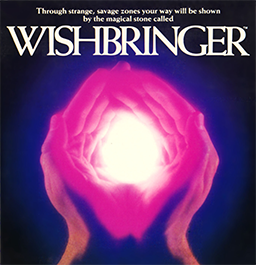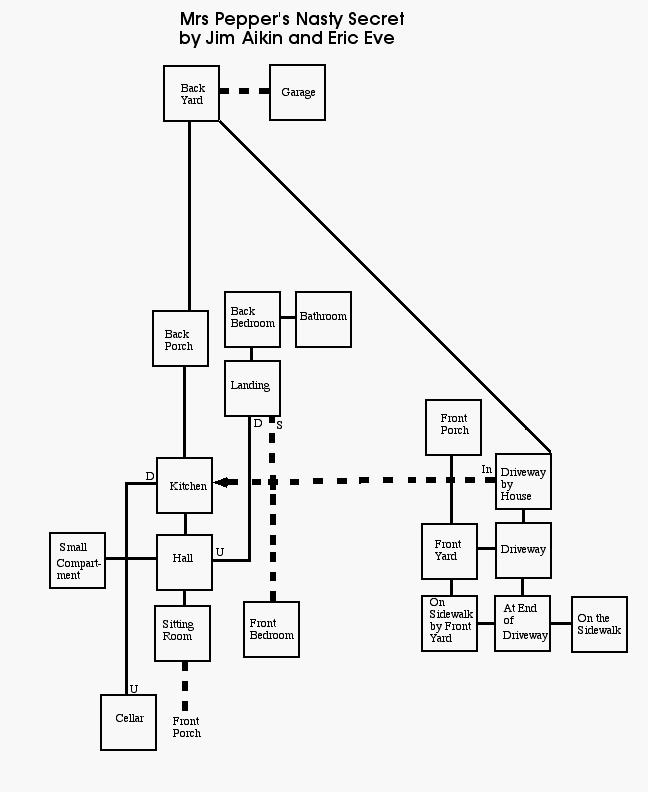Effective Thinking
We can understand the thinking processes involved in interactive fiction as an application of Robert J. Sternberg’s componential theory of intelligence. Expressed in a 1984 article in Educational Leadership (“How Can We Teach Intelligence?” Sept., 38-48) and elaborated on in his book Intelligence Applied (1986, New York: Harcourt), Sternberg’s theory tries to understand intelligence partly in terms of three kinds of component processes. “Metacomponents” control intelligent behavior by planning, monitoring, and evaluating it. “Performance components,” such as inferring similarities and differences, actually carry out the plans for thinking that the metacomponents decide on. And “knowledge acquisition components” enable the thinker to gain new information, including information that the other kinds of components may use. For example, if I were deciding to buy one of two automobiles, the metacomponents of my intelligence would enable me to choose comparing and contrasting as part of my strategy for making a good decision. I would also use metacomponents to monitor my strategy as I used it and to evaluate its outcome. The actual comparing and contrasting, though, would be performance components; and my techniques for gathering information about the cars, such as reading about them or directly inspecting them, would be knowledge acquisition components. Interactive fiction, like any kind of literature, involves all three kinds of components, but it offers an especially compelling approach to metacomponents in that it forces readers to think about how they are controlling their thinking.
Recognizing Problems in Planetfall and Aotearoa
At the beginning of one classic work of interactive fiction, Steve Meretzky’s Planetfall (1983, Infocom), the reader must exercise a metacomponent that textbooks seldom ask students to use but that Sternberg considers essential to intelligent behavior, the ability to recognize and define the nature of a problem. Here is the beginning of the story:
“Another routine day of drudgery aboard the stellar patrol ship Feinstein. This morning’s assignment for a certain lowly ensign seventh class: scrubbing the filthy metal deck at the port end of Level Nine. With your patrol-issue self-contained multi-purpose scrub-brush you shine the floor with a diligence born of the knowledge that at any moment dreaded Ensign First Class Blather, the bane of your shipboard existence, could appear.”
What exactly are the problems here? Well, one problem seems to be to get the deck clean, a problem that seems to call for persistent scrubbing, and so we might try typing in at the computer keyboard, “Scrub deck.” If we do so, the program responds with the not-too-exciting, “The deck looks a little cleaner now.” But perhaps a more important problem we face here is a lack of knowledge of our surroundings. Maybe we should activate a knowledge-acquisition component and explore. Our location at the start of the story, Level Nine, offers two exits, a corridor to starboard and a gangway leading up. If we go up to Level Eight, we meet another character, the aforementioned “dreaded Ensign Blather,” who assigns us twenty demerits and belligerently orders us to return to our post. Here we have another apparent problem, which may suggest solutions such as obedience, arguing, or a punch in the jaw. In interactive fiction, we can try out any or all of these approaches. If we do so, we find that punching Blather causes him to dismember us (not to worry, though; in interactive fiction, death is just the program’s way of telling us we’ve taken a misstep), that arguing with Blather at length causes us to be thrown into the brig, and that going back to work leads to a comic encounter with a broccoli-like alien ambassador who drips slime all over the deck we’re shining. Eventually, though, we learn that the last of these approaches works best, since the ship we are on soon explodes and our position on Deck Nine proves especially convenient to an escape pod. In the pod, of course, we must again identify the nature of the problem(s) we face and try to deal with them; and only after we land on the planet to which the pod takes us, will we figure out that the central problem of the story is to bring the planet’s inhabitants back to life and to return to the stellar patrol.
In Aotearoa, by Matt Wigdhal (2010), we find a similar problem-recognition challenge that confronts a younger protagonist on a Conservation Service vessel off New Zealand. This time, Tim, a twelve-year-old contest winner, facing no obvious problem, must travel around the boat on which he finds himself, conversing with other characters and gathering information that will help him later in the story. In other words, the interactor who’s running Tim’s character must, at least tentatively, identify a minimum of one problem, a problem that hinges finding useful information. Eventually, as in Plantefall, a disaster about ship forces Tim to confront some more obvious problems and to use the information that he has gathered.
For IF beginners Aotearoa, offers some special advantages, in addition to its kid-friendly themes, which include family relationships and dinosaur conservation. The story, like a significant number of contemporary IF works, includes a “novice mode,” which displays helpful suggestions, based on the user’s input.
Representing Problems in Wishbringer and Mrs. Pepper’s Nasty Secret

Wishbringer (1985, Infocom), an award-winning work of IF by Brian Moriarty, offers an amusing instance of a second ability which, according to Sternberg, underlies intelligent behavior, the ability to decide on how to represent problem information. In this relatively easy interactive novel, the main character eventually finds himself in the lair of a dangerous, light-hating monster known as a grue, as he searches for, among other things, grue’s milk. In the lair, he finds a sleeping baby grue and a refrigerator. When he opens the refrigerator door, he notes that a small light goes off, but since he’s carrying his own source of light, he can see a bottle of milk inside. Unfortunately, though, because of the light, the baby grue wakes up and howls like “the screeching of a subway,” summoning a horrible monster with “a calico apron and slavering fangs,” which promptly dispatches the protagonist. Now, after using a few simple keystrokes to recall to the computer’s memory a “snapshot” of the game just before the opening of the door, the readers have a problem to solve, a problem that will probably lead to the question, “How can I get the grue’s milk out of the refrigerator?” However, with (or better, without) a little coaching, readers may see that other, more complete representations of the problem can facilitate a solution. They may move to, “How can I kill the baby grue in order to get the grue’s milk safely?” but since there are no weapons in the story, this formulation doesn’t help much. Sooner or later, though, they will probably try, “How can I keep the baby grue asleep in order to get the grue’s milk safely?” a very helpful version in that the protagonist has easy access to a blanket. Of course, other readers may solve the problem through other sorts of alternative representations, as by drawing mental or physical pictures of the scene, thus using visualizing techniques that English teachers often urge students to try.
At the beginning of Mrs. Pepper’s Nasty Secret by Jim Aiken and Eric Eve (2008), we find a different sort of problem-restating challenge. Here’s a slightly edited version of the story’s beginning.
Walking home from school is mostly okay, except for one big problem: Every day you have to pass right by Mrs. Pepper’s house. She seems to go out of her way to cause trouble for you. Once, she came at you with the garden rake, swinging it like it was a giant claw … you still shudder when you think of it.
Last Friday was a new low. You would never, ever skateboard in her driveway — that would be practically suicidal. But somehow when you got to the driveway your skateboard swerved, all by itself, as if somebody had put a spell on it.
And then you fell off.
While you were picking grit out of the ugly scrape on your skinned elbow, Mrs. Pepper appeared out of nowhere and snatched up your skateboard! She screeched something about rowdy children, trespassing, and needing to be taught a lesson.
She swung the skateboard at you like it was a bat, and then ran off with it, cackling. Afterward you rang her doorbell for what seemed like an hour, begging her to give the skateboard back, and she wouldn’t even come to the door.
And now it’s Monday afternoon, and here you are, on your way home from school as usual (but with no skateboard). Just up ahead is Mrs. Pepper’s driveway.
Here, the authors have given us two clear problems to consider. We apparently have to avoid more trouble with Mrs. Pepper, and our player/character would clearly like to get his or her skateboard back. Very soon, though, using a trope favored by many IF authors, Aiken and Eve offer an overriding problem. Here’s the relevant passage from the story.
>Go west.
On the Sidewalk by the Front Yard
To the north, across a sadly dried-up and decrepit yard, stands Mrs. Pepper’s house. You can also go east or west along the sidewalk. The busy street is to the south. A telephone pole plastered with the scraps of old posters stands here.
>Go north.
You take a cautious step onto Mrs. Pepper’s property. When nothing terrible happens, you take another, your curiosity overcoming your apprehension of the batty old woman.
Front Yard
The front yard is mostly bare dirt and burned-out brown lawn, except for a few hardy weeds. A paved walkway crosses it, leading from the sidewalk on the south up to the front porch on the north. The driveway runs past the yard on the east side, and a tall fence guards what must be the neighbors’ yard on the west. Growing next to the walkway is a scraggly, half-dead tree.
As you’re crossing the front yard, a momentary lull in the traffic noise allows you to hear something very odd. Weakly, somewhere in the near distance, a voice is crying, “Help me! Oh, please, help me!” The voice is high-pitched and very hoarse, as if whoever is calling for help can barely speak at all.
You stop dead in your tracks, looking around to see where the voice might be coming from. It seems to be coming from the upstairs window in Mrs. Pepper’s house. You stare hard at the window, and for a moment it seems something might be moving there — but you can’t make out what it might be. After a moment the movement stops, and the voice falls silent.
Could it have been your imagination? No, you’re certain you heard something.
And it was coming from inside the house.
Now, we have a new problem, perhaps related to the others in some way, but definitely more pressing. Perhaps with a bit of guidance from their teacher, students will soon determine that the problem of helping Mrs. Pepper’s prisoner will almost surely have to be divided into smaller problems if it is to be solved. Even before experimenting further, thoughtful student problem-solvers might come up with a list of barriers that their player-character is likely to face. This list will, in effect, restate the overriding problem into a series of more manageable issues. These sub-problems might include determining whether Mrs. Pepper is at home, getting into her house, finding the prisoner, and helping the prisoner to escape. As students work through the story, they will almost surely find that this sort of problem-dividing skill will stand them in good stead.
Other Thinking Skills
Like the problem-recognition instances in Planetfall and Aotearoa, these problem-representation examples are by no means unusual in interactive fiction. In fact, every good piece of IF challenges the reader to use these abilities and many more that Sternberg stresses. IF readers must carefully monitor their solution processing because surprising, and sometimes even random, events can occur at unexpected times in familiar settings, as in Wishbringer, when the Boot Patrol, a magical police troop consisting of gigantic, smelly boots, suddenly threatens. Readers must evaluate their solutions, since some apparently good results, such as the capture of the apparently larcenous title character in Bonnie Mongomery’s The Firebird (1999), may turn out to be serious mistakes. Mental and physical resources must be allocated to various problems, as by deciding which of the many available objects to carry around in Laura Knauth’s Winter Wonderland (1999). Readers must apply old relations to new situations, as in deciding whether to respect the orders of Perelman, an important character in A Mind Forever Voyaging (Meretzky 1985, Infocom), a work of serious science fiction that many readers regard as one of the finest pieces of IF yet written. Likewise, readers must make automatic some elements of their information processing, as by mapping the twenty-five locations in Robin & Orchid by Ryan Veeder and Emily Boegheim (2013).
How Do We Know That IF Works?
IF is a form of text literature, a form that happens to be particularly motivational for many students. Like other forms of literature, it offers opportunities for students to study a variety of literary themes and techniques, including character, setting, and tone, though a few such techniques, especially plot and point of view, get new twists in IF.
Still, a teacher might wonder whether IF can really help students to achieve goals that may seem a little more arcane, such as controlling their own thinking more effectively. In my own school, we try to help students develop a variety of metacognitive techniques, with special emphasis on planning; and so, several years ago, I initiated a field study of IF and student planning.
How does one measure a student’s ability to plan well? Such a measurement would have to be unobtrusive, since we would want to know, among other things, whether a student could recognize an appropriate situation for planning without prompting from a teacher. Further, the student would have to have a chance to show her own ability to create a good plan, without the kind of prompting that multiple-choice or short-answer instruments usually provide.
My colleagues and I decided, then, that we would need a brief essay test of some sort, a test that could pass for a simple journal-writing assignment, while enabling us to reliably observe students’ planning skills. After a course with Edys Quellmalz, a nationally-prominent designer of essay tests of critical thinking, I developed two prompts for journal writing assignments that, answered in a complete and thorough way, would require the student to set out an explicit plan. Then, with the help of my colleagues, I worked out and tested a scoring rubric.
In 1989, I tried out the instrument with a real class, using one prompt before the students studied planning through IF and another after they did so. The pre-test showed little sensitivity to the need for planning, though students who planned at all showed some skill at it. The post-test revealed a clear improvement, statistically signigicant at the p<.003 level.
I do not claim much for this study. Indeed, I suspect that one could obtain similar results though skillful teaching for planning without any use of IF at all. Nevertheless, IF offers, for students of literature, a unique and appealing vehicle; and this study offers evidence that it works, as part of a well-conceived effort to help people think more effectively.
And what about those unwelcome standardized tests? As you might expect, there are no rigorous studies on interactive fiction and high-stakes testing. However, my middle school students, who received a substantial part of their English language arts instruction, over several years, did very well on the Massachusetts (USA) Comprehensive Assessment System (MCAS) tests, which were among the most rigorous in the nation. In 1999, when the standardized-testing boom was first gathering momentum, only one grade in each middle school had to take the MCAS Language Arts Test. In that year, as it happened, a significant percentage of the tested students worked with interactive fiction, and the school achieved the second highest MCAS Language Arts scores in the state. In 2000, the tested grade, many of whom had extensive interactive fiction instruction, tied for the best language arts scores in Massachusetts. Through the subsequent years of the deceptively-named “No Child Left Behind” initiative, students who studied interactive fiction continued to do well, even in the context of a high-achieving school that reached every “Adequate Yearly Progress” target through 2008.
Try It!
With one student at the computer, even an older PC or Mac, typing what a class wants to try and reading the results aloud, and the rest of the class actively engaged in mapping, keeping track of problems, and generating suggestions, interactive fiction can become an engaging experience for groups of almost any size, an experience that involves students in the essential kind of thinking that we call reading. With a large-screen display, the group reading of IF stories can be even more dramatic. IF encourages the kind of systematic, consciously planned metathinking that Sternberg advocates and that English teachers know their students need. And at its best, it offers a surprise that is of great value: as a new and vibrant (if not yet fully developed) form of literature, it can spark a renewed sense of wonder at the power of the written word.




